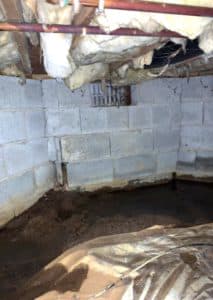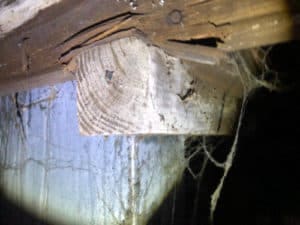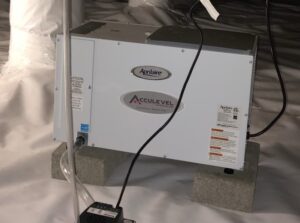Do I Need a Dehumidifier in My Crawl Space?

Originally posted: 7/30/19. Revised by Kelly Kater on 6/21/21
Since you don’t spend a lot (or any!) time in your crawl space, you might not worry much about dampness beneath your home. But this could be a big mistake- moisture can cause significant problems for the structure of your home. It can also pose risks for the health of you and your family, and it will definitely affect your comfort.
The best way to prevent moisture in your crawl space and counteract the effects of humidity is a whole-home dehumidifier.
Acculevel has been repairing foundations and waterproofing crawl spaces since 1996. Founded by Andy Beery, they are a family-owned and operated company that serves Indiana and the surrounding states. Everyone deserves a safe and healthy home, and we want to help you preserve yours.
In this blog, we’re going to explore the various sources of moisture in a crawlspace, the effects it can have on your home, and signs that you need to take action.
 This photo was taken by an Acculevel project manager during a routine free estimate.
This photo was taken by an Acculevel project manager during a routine free estimate.
How Does Water Get Into My Crawl Space?
Water can get into your crawl space from a number of sources. If you have standing water, the culprits are usually a leak, poor drainage around the house, or cracks in the foundation. We highly recommend that homeowners review their downspouts when they clean the guttering. If your downspouts are draining less than 10 feet away from your foundation, they may be part of the problem. Water collecting around your foundation causes hydrostatic pressure, which puts stress on your foundation and creates damage.
Condensation on pipes and HVAC equipment contributes to moisture in your crawl space. Water can also evaporate directly from the ground and collect in the crawl space, if you don’t have a vapor barrier in place. (Vapor barriers are sometimes called moisture barriers for this reason.)
What Will Happen if I Don’t Have a Dehumidifier?
Moisture creates a variety of problems in a home. When you add the dust that occurs in a crawl space to moisture, that provides the ingredients needed for mold to flourish. If you or a family member has asthma, allergies, a respiratory condition, or a compromised immune system, mold can produce substantial health risks. In some studies, mold has been shown to contribute to the development of asthma- especially in children. We explore this topic more thoroughly in a blog we’ve written specifically about mold.
Elevated moisture levels aren’t good for your house and belongings, either. Most materials such as fabrics, wood, and electronic components can sustain damage from exposure to moisture. The structure of your home is not immune to this, either. Moisture and humidity contribute to the decay of your structural flooring system, also. Most of the supporting parts that make up your floor are made of wood: floor joists, sill plates, even the main beam. Once these begin to decay, your floors will begin sagging or sloping.
 This photo was taken by an Acculevel project manager during a routine free estimate. The floor joist has rotted, and crumbled where it rests on the center beam.
This photo was taken by an Acculevel project manager during a routine free estimate. The floor joist has rotted, and crumbled where it rests on the center beam.
Too much humidity can cost you money in utility bills, too. Your HVAC unit negates some humidity when it runs, but that’s not its primary function. Forcing it to compensate for extra moisture adds wear and tear on the machinery. Adding a dehumidifier will reduce the stress on the HVAC system, while also allowing you to lower the thermostat. Dry air feels cooler than moist air. You should be able to bump up the temperature in your home by a few degrees, if the air is cool and dry instead of cold and damp.
Not sure what kind of dehumidifier is right for you? We have an article that compares DIY methods, portable versions, and whole-home dehumidifiers.
How Can I Tell if I Need a Dehumidifier?
You may not notice right away that you have a problem. After all, most homeowners don’t go into their crawl space unless absolutely necessary. But there are some signs for you to watch for:
- A strong musty odor
- Moisture on the inside of your windows
- Clammy or “sticky” feeling, even when the A/C is on
- Creaking, sagging, or sloping floors
- Cracks in drywall
- Gaps between floor and baseboard.
If you already have some of these symptoms- especially the first three- then you should invest in a whole-house dehumidifier. For mold treatment and sagging floor issues, you should look for a reputable and experienced contractor to make the needed repairs.
You may also want to consider encapsulation. This takes waterproofing to the next level in a crawl space. An encapsulated crawl space is clean, dry, free of pests or mold, and capable of being used as storage space.

This photo was taken by an Acculevel crew member after encapsulation was completed.
Do You Have More Questions about Your Crawl Space?
Please check out our Crawl Space Repair Guide for homeowners. Our goal with this guide is to address all of our customers’ frequently asked questions, explore what causes the most typical problems, and review the solutions to those problems. We also provide pricing for these repairs, explain how the repairs are made, and how you can prevent issues in the future.

